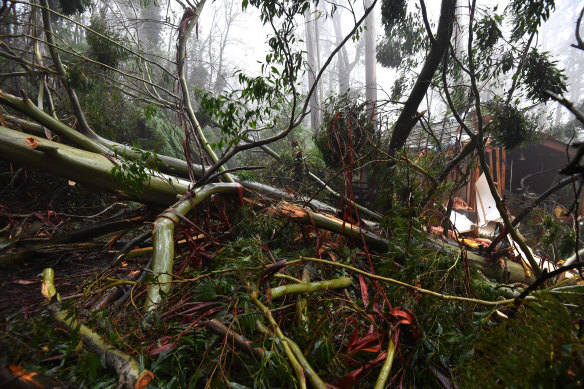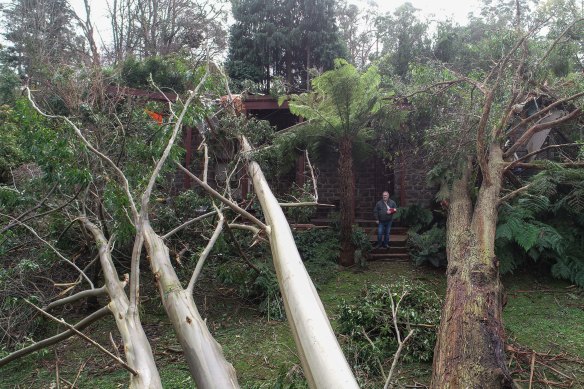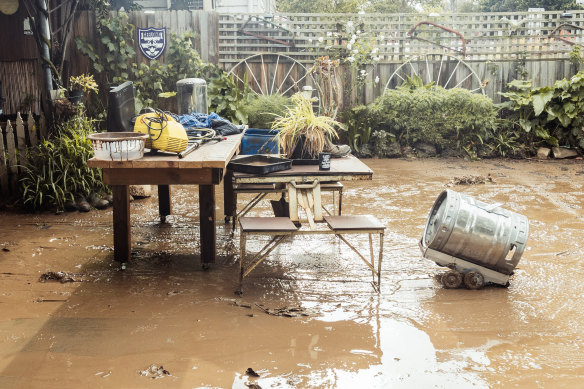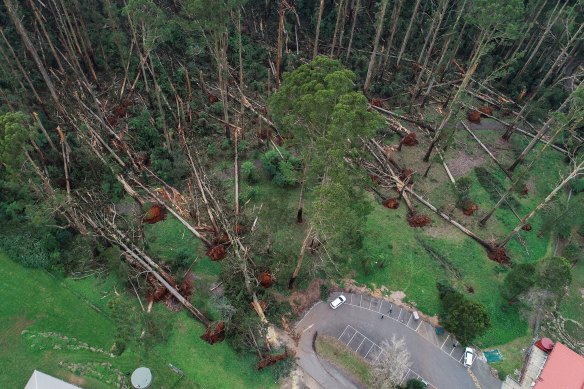This was published 2 years ago
Where beauty meets danger, there’s a risk people are willing to take
By Bianca Hall and Benjamin Preiss
People who live among the temperate rain forests of the Dandenong Ranges – home to soaring trees of mountain ash, pines and tree ferns – know their lifestyle comes with risks.
It is a risk most remain willing to take. But the severity of the past fortnight’s storms, and their trail of destruction, has raised questions about the dangers of building homes in areas prone to natural disasters and whether planning rules restricting growth need to be strengthened.
The June 9 storms left more than 200,000 households and businesses without power statewide and the SES has received 9500 calls for help from the SES since June 9.

Storms wrought widespread destruction in Olinda and other parts of the Dandenongs, east of Melbourne, last week. Credit: Joe Armao
Since Black Saturday, planners and governments have focused on the risk of bushfires. The recent extreme weather, however, has shown the climate risks in so-called peri-urban areas – townships and suburbs on the periphery of urban settings – go far beyond fires.
Planning expert Michael Buxton, who lives in Emerald, says the destruction caused by the storms should prompt the Andrews government to re-examine its planning controls for new residential development in risk-prone areas.
But he warns that managing the risks of living in outer-urban areas like the Dandenongs must not spark any rearguard action that would threaten their inherent value.
“If governments don’t act to protect those areas, their very attractiveness becomes the means of their destruction.

Trees did extensive damage to John Carlyle’s home in Kalorama during the storm. Credit: Joe Armao
“If too many people are allowed in and too much development occurs, then that population increase destroys the very thing that attracts people. Most people who live here love the trees, they love the environment. They put up with the disadvantages like relatively poor transport and high risk, because it’s a trade-off.”
The damaging storms of June 9 wrought havoc across three main regions: the Yarra Ranges, particularly the Dandenongs; the Hepburn, Moorabool and Ballarat regions; and Gippsland – although damage was also recorded elsewhere.
Melbourne University arboriculture expert Dr Greg Moore has argued the storms show the early warnings about climate change are becoming manifest.
He says wind directions are becoming more unpredictable because of climate change (during the storms that hit the Dandenongs, wind gusts came from the south-east rather than in a north-westerly or westerly direction).

The storms brought floods to Traralgon, causing major damage to Les Davidson’s home. Credit: Blake Bourne
Sudden rainfalls softened soils, and this – combined with strong winds blowing from atypical directions – resulted in trees falling like ninepins in the extreme weather.
“What you’re seeing is the predictions of climate change that were made the best part of 30 years ago coming to fruition,” he says.
Planning Minister Richard Wynne tells The Age that after the 2009 Victorian Bushfires Royal Commission, the government amended its planning system to require planners to consider alternative locations for development and not increase bushfire risks to existing and future residents.
“Human life takes precedence over all other planning considerations,” he says.
“Many of these houses and towns were built decades before bushfire planning laws were in place. The government has been working hard to future proof our planning system in the face of climate change since 2014.”
He says planning laws sought to ensure new developments, including in peri-urban areas, took erosion and flooding risk into consideration.
Yarra Ranges mayor Fiona McAllister, who lives in Healesville, says it would be simplistic to ban people from living in certain areas.
“We have coastal risks, we have fire risks, we have storm risks,” she says. “In urban areas there are other risks.”
Cr McAllister insists the Yarra Ranges has strong planning overlays –including for bushfire and erosion – and rules that guide development.

Massive trees fell like ninepins near Mount Dandenong Primary School. Credit: Joe Armao
“We have a pretty stringent building code. We’ll support the [appropriate] level of protection and minimise risk where possible.”
Some local communities in the area are already starting to talk about better protecting themselves, Cr McAllister says, while others are still focused on the immediate recovery from the storm.
“For some communities it will take longer before they’re ready to be part of that conversation.”
Melbourne University professor of urban planning and disaster risk reduction, Alan March, says there is a policy gap in planning to mitigate tree strike in places like the Dandenong Ranges.
He says native trees are protected for good reason but they present dangers to those who live between them.
“In some ways that puts us in a bit of a policy bind where we’re trying to achieve a certain set of goals that cut across the human safety and life goals,” he says.
Professor March says life in the Dandenongs brings many benefits associated with being surrounded by nature but there are myriad dangers.
“Unfortunately those bits of hilly terrain with a lot of eucalypts on narrow, winding and often steep roads are very challenging.”
Actuaries Institute climate risk working group convenor Rade Musulin says storms tend not to create a strong immediate response from insurers because they usually happen randomly over large areas.
“Unlike floods you don’t actually have a river bank or a really clear place where all the risk resides,” he says. “But having said that I do think when you have events like this they can increase scrutiny on hazards like trees.”
The Victorian planning scheme contains clauses that seek to address this balance. In an environmental risks section, it advises that new developments “should aim to avoid or minimise natural and human-made environmental hazards, environmental degradation and amenity conflicts”.
It says that new population growth should be directed to low-risk areas. A new clause, introduced after the Black Saturday bushfires and intended to reduce the risk of lives and property being lost, directs: “The protection of human life [should be prioritised] over all other policy considerations.”
The Morning Edition newsletter is our guide to the day’s most important and interesting stories, analysis and insights. Sign up here.